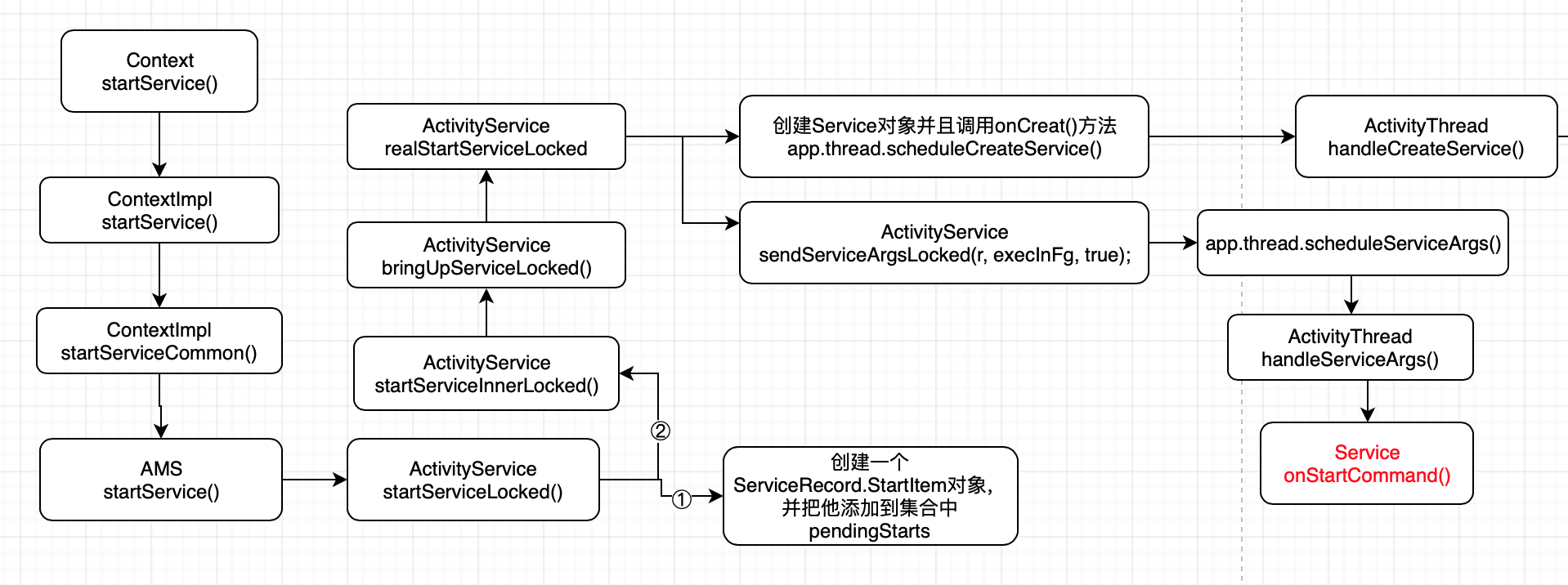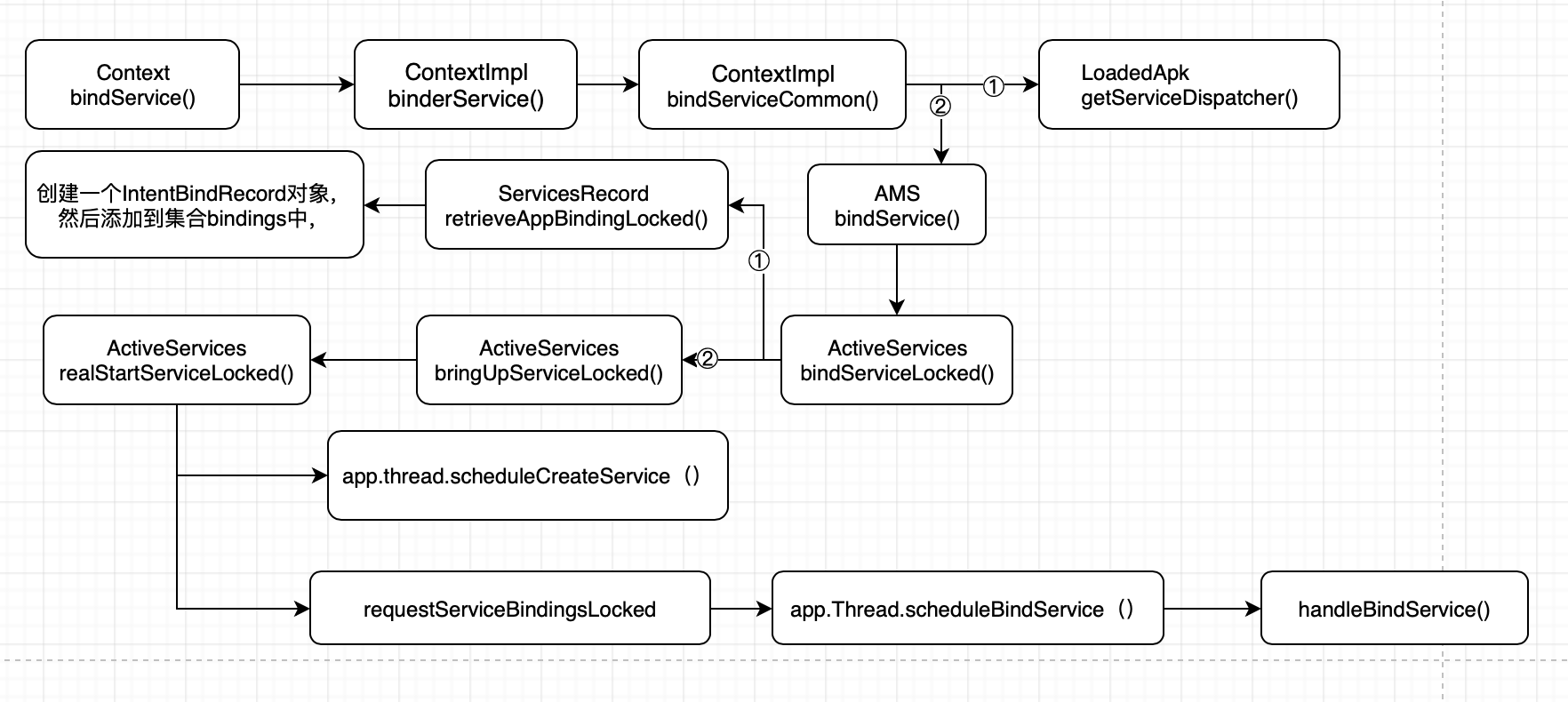Android 四大组件之 Service
类名解释
AMS
ActivityService
辅助 AMS 进行 Service 管理的的类,包括 Service 的启动,绑定和停止等
ServiceRecord
一个 Service 的记录类,可以理解为 Service 的栈吧。
还是之前的原则,能上图绝不贴代码
Service 的工作流程
startService()
都知道, startService() 是 Context 中的方法,而 ContextImpl 是 Context 的子类。所以流程图如下。

又看到 AMS 了,就知道和这个有关, startService() 应该和 startActivity() 有很多类似的地方吧。 两次 IPC 通信
肯定会和 ApplicationThread 还有 ActivityThread 有关,又肯定会套用我之前的公式吧
第一个 IPC 通信是在 ContextImpl 的 startServiceCommon() 中。
第二次的 IPC 通信是在 ActivityService 的 realStartServiceLocked() ,(好像 startActivity() 的第二次 IPC 通信名称是在 realStartActivityLocked() ,名称好像啊。) 看红色字体,熟悉吧, onStartCommand() ,执行了
然后再详细看看 handleCreateService() 的流程吧
ActivityThread # handleCreateService()

在handleCreateService()
- 创建了 Service 对象
- 如果 Application 没有创建,创建 Application 对象并执行 onCreate() 方法
- 执行 Service 的 attch() ,把 Service 和 ContextImpl 关联起来
- 执行 Service 的onCreate()
- 把 Service 添加到一个队列中。(干嘛用的??)
不是说多次 startService() , Service 的 onCreat() 方法只会执行一次啊,没看到相应的逻辑。留个疑问。
这样 startService() 的流程就完成了
bindService()

关注的重点:
- 在 getServiceDispatcher() 中,将 ServiceConnection 对象转换为ServiceDispatcher.InnerConnection,并添加到集合 mService 中。因为服务的绑定可能是夸进程的,因此 ServiceConnection 必须得借助 Binder 才能让远程的服务端回调自己的方法。ServiceDispatcher.InnerConnection 正好充当 Binder 的角色。这样当 Service 和客户端建立连接后,系统就会通过 InnerConnection 来调用 ServiceConnection 的onServcieConnected()
- ServiceDispatcher的作用就是连接 ServiceConnection 和InnerConnection
- 和 startService() 一样,都会执行到 realStartServiceLocked()
这就产生疑问了,怎么这个也执行到了 realStartServiceLocked() 。可是后面为啥又不一样了呢?分久必合合久必分?这个先放以下,先继续看 handleBindService() 都做了啥操作吧
ActivityThread # handleBindService()
流程图来一份

看到了熟悉的 onBind() 和 onServiceConnected() 了
因为ServiceDispatcher.InnerConnection 的 connect() 是在 Binder 线程池中运行的,所以在ServiceDispatcher connected() 才会 post 一个 Runnable 对象,切换到主线程中。然后再执行Connection.onServiceConnected()
这样 bindService() 的流程也就结束了。
现在来看分久必合合久必分的问题。
bindService()和 startService() 怎么区分
其实是一样的。这个就要贴代码了 realStartServiceLocked() 三个流程都执行了,只不过不同的场景,在不同的方法中返回不一样而已。
private final void realStartServiceLocked(ServiceRecord r, ProcessRecord app , boolean execInFg) throws RemoteException {
//创建 Service 对象,并且调用onCreat()
app.thread.scheduleCreateService(r, r.serviceInfo, mAm.compatibilityInfoForPackageLocked(r.serviceInfo.applicationInfo), app.repProcState);
...
requestServiceBindingsLocked(r, execInFg);
...
//通过sendServiceArgsLocked()调用 Service 的其他方法,比如onStatCommand()
sendServiceArgsLocked(r, execInFg , true);
...
}
既然 bindService() 也执行了 调用了 sendServiceArgsLocked() ,为啥没执行 onStartCommand() 呢。原因如下:
从 startSrvice() 那个图也看出来了。在 执行 realStartServiceLocked() 之前, startServiceLocked() 中会有
r.pendingStarts.add(new ServiceRecord.StartItem(r, false , r.makeNextStartId(), service , neededGrants));
这样一段代码, 创建一个 ServiceRecord.StartItem 对象,然后添加到了集合 pendingStarts 中 可以理解把 startService() 要启动的 Service 添加到了集合 pendingStarts 中
//ServiceRecord.java
final ArrayList<StartItem> pendingStarts = new ArrayList<StartItem>();
而在 sendServiceArgsLocked() 中就会有对 pendingStarts 这个集合的操作。
private final void sendServiceArgsLocked(ServiceRecord r, boolean execInFg , boolean oomAdjusted){
final int N = r.pendingStarts.size();
if (N == 0) {
return;
}
//会执行到 onStartCommond() 方法
}
bindService() 没执行 startServiceLocked() ,所以 pendingStarts 集合是空的,那么就直接 return 了。
同理,在 bindService() 流程图中,在执行 realStartServiceLocked() 之前, bindServiceLocked() 也有一个类似的操作。会执行到 ServiceRecord 的 retrieveAppBindingLocked() ,在这里会创建一个 IntentBindRecord 对象,然后添加到集合 bindings 中,
//ServiceRecord.java
final ArrayMap<Intent.FilterComparison, IntentBindRecord> bindings = new ArrayMap<Intent.FilterComparison, IntentBindRecord>();
public AppBindRecord retrieveAppBindingLocked(Intent intent, ProcessRecord app) {
Intent.FilterComparison filter = new Intent.FilterComparison(intent);
IntentBindRecord i = bindings.get(filter);
if (i == null) {
i = new IntentBindRecord(this, filter);
bindings.put(filter, i);
}
AppBindRecord a = i.apps.get(app);
if (a != null) {
return a;
}
a = new AppBindRecord(this, i , app);
i.apps.put(app, a);
return a;
}
而在 requestServiceBindingsLocked() 中,也有对 bindings 的操作。
private final void requestServiceBindingsLocked(ServiceRecord r, boolean execInFg) {
for (int i = r.bindings.size() - 1; i >= 0; i--) {
IntentBindRecord ibr = r.bindings.valueAt(i);
if (!requestServiceBindingLocked(r, ibr , execInFg , false)) {
break;
}
}
}
因为 startService() 不会执行到 bindServiceLocked() 中,所以 bindings 这个集合就是空的,那么 for 循环就不会执行,也就执行不到 requestServiceBindingLocked() ,从而不会调用 onBind() 方法。
搬运地址:
Android 开发艺术探索
既已览卷至此,何不品评一二: